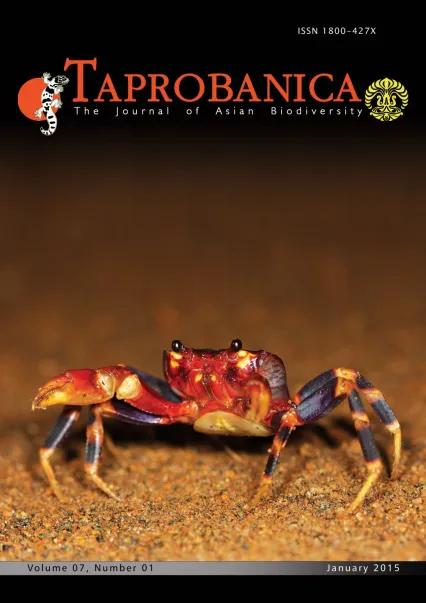

v7i1.149
Volume 7 | Number 1 | May 2015
Major Article
ISSN: 1800-427X (print)
eISSN: 1800-427X (online)
DOI:10.47605/tapro.v7i1.149
Submitted date: 4 December 2013
Accepted date: 10 October 2014
Published date: 19 January 2015
Pp. 8–13, Pl. 4–8.
DISPLAY BEHAVIOUR OF INDIAN PEAFOWL Pavo cristatus (AVES: GALLIFORMES) DURING THE MATING SEASON IN VIRALIMALAI, TAMILNADU, INDIA
Varadharajan Gokula & V. Muthukrishnan
*Corresponding author. E-mail: gokulae@yahoo.com
Abstract
The Indian peafowl (Pavo cristatus), the largest of the pheasants in India, inhabits mostly semi-arid conditions. We examined the courtship displays of free-ranging peacocks in relation to the orientation and the relative positions of females being courted from August 2012 to January 2013 in Viralimalai, Tamil Nadu, India, to address these questions: (1) Do the peacocks orient their courtship display towards the sun? (2) Is there any relationship between the presence of peahen and the duration of display of peacock? (3) Is there any site-preference to display? We found that the majority of the displays were oriented towards the sun initially, but then oriented towards peahen (regardless of direction) soon after their arrival. Although peacock displayed even in the absence of peahen, presence of peahen influenced the display duration of peacock. Displays were performed largely in open areas.
Key words : courtship, orientation, peahen, pheasants, semi-arid habitats, South India
Section Editor: S.M. Henkanaththegedara
eISSN: 1800-427X (online)
DOI:10.47605/tapro.v7i1.149
Submitted date: 4 December 2013
Accepted date: 10 October 2014
Published date: 19 January 2015
Pp. 8–13, Pl. 4–8.
DISPLAY BEHAVIOUR OF INDIAN PEAFOWL Pavo cristatus (AVES: GALLIFORMES) DURING THE MATING SEASON IN VIRALIMALAI, TAMILNADU, INDIA
Varadharajan Gokula & V. Muthukrishnan
*Corresponding author. E-mail: gokulae@yahoo.com
Abstract
The Indian peafowl (Pavo cristatus), the largest of the pheasants in India, inhabits mostly semi-arid conditions. We examined the courtship displays of free-ranging peacocks in relation to the orientation and the relative positions of females being courted from August 2012 to January 2013 in Viralimalai, Tamil Nadu, India, to address these questions: (1) Do the peacocks orient their courtship display towards the sun? (2) Is there any relationship between the presence of peahen and the duration of display of peacock? (3) Is there any site-preference to display? We found that the majority of the displays were oriented towards the sun initially, but then oriented towards peahen (regardless of direction) soon after their arrival. Although peacock displayed even in the absence of peahen, presence of peahen influenced the display duration of peacock. Displays were performed largely in open areas.
Key words : courtship, orientation, peahen, pheasants, semi-arid habitats, South India
Section Editor: S.M. Henkanaththegedara
- List of Articles & Contents





